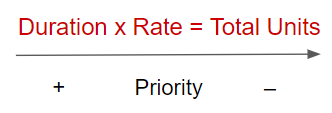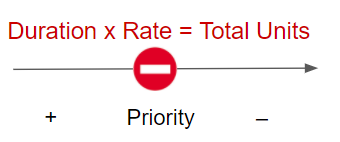When talking about projects, most of the resources are people, as to say the project teams. However, projects might also need Equipment, Materials, Supplies, Facilities, and Infrastructure to proceed as planned.
In Sciforma, Labor and Non-Labor resources are assigned different names:
Resources are human resources – Nominative Resources and Generic Resources.
Cost items are non-human resources – materials, machinery, etc.
The importance of Cost Items management is not necessarily related to costs as their use might not impact your project cost but likely impact availability for some other project or operation. For this reason, it is important to estimate the Time requirement for the Cost Items.
At the appropriate time you will acquire the Cost Items and assign them to their respective Activities. Too early acquisition adds unnecessary cost and prevents others from using shared resources. Too late acquisition, of course, impacts project schedule. For similar reasons, timely release of acquired Cost Items is also important.
The Distribution Type governs how the cost item is allocated over the length of a task.
The following equation is used to relate the Duration, Rate, and Total Unit within a cost item assignment:
DURATION x RATE = TOTAL UNITS
The equation has three variables. In order for Sciforma to use this equation, you will have to set one of the variables (Duration, Rate or Total Units).
With these three distribution types, priorities are given to the three variables in the equation as follows:
The Fixed Rate distribution type maintains a constant Rate regardless of changes that are made to the Duration of the task. It automatically adjusts the Total Units as the Duration of the task changes to keep the Rate constant. If you manually adjust the Rate of the cost item assignment, then Sciforma adjusts the Total Units while holding the Duration constant.
The Fixed Effort distribution type maintains a constant Total Units regardless of changes that are made to the Duration of the task. When the Duration changes, the Rate is recalculated. If a task's Duration increases, the Rate decreases. If a task's Duration decreases, the Rate increases. In all of those cases, Total Units are held constant.
If you modify the Total Units on a cost item assignment that has a Fixed Effort distribution type, Sciforma changes the Rate while holding the Duration constant.
The Fixed Duration distribution type maintains a constant Duration for the task and varies the Rate to meet the needs of the cost item assignment. Regardless of how the Rate is changed, the Duration does not change as a result. The Total Units consumed is computed by multiplying the Duration of the task by the Rate. If the Duration is extended, more of the cost item is consumed. If the Duration becomes shorter, less of the cost item is consumed.
In the table below, each cell contains the parameter recalculated by Sciforma when the user changes a parameter (listed in rows) with a given Distribution Type (listed in columns).
Fixed Rate | Fixed Effort | Fixed Duration | |
|---|---|---|---|
Rate | Units* | Duration | Unit |
Units | Duration | Rate* | Rate |
Duration | Units | Rate | Units* |
The cells with an asterisk display variables that have been calculated by Sciforma due to the priority Sciforma uses in the equation Duration x Rate = Total Units. These cells correspond to the result of the change in the variable that has been recalculated.
In case users might not designate Duration as the highest priority, three additional distribution types are also available: Fixed Rate-Effort, Fixed Effort-Rate, and Fixed Duration-Effort.
With these three distribution types, Sciforma still uses the same equation, but the priorities of the variables are not taken into account.
Priorities are defined as in the following table:
Highest priority | Medium priority | Lowest priority | |
|---|---|---|---|
Fixed Duration - Effort | Duration | Units | Rate |
Fixed Rate - Effort | Rate | Units | Duration |
Fixed Effort - Rate | Units | Rate | Duration |
The Fixed Duration-Effort distribution type works the same as Fixed Duration when changes are made to the Rate. It maintains a constant Duration and secondarily maintains a fixed Total Units. However, this option also maintains a fixed Total Units and changes the Rate when changes are made to Duration (whereas if project managers had selected Fixed Duration instead, changes to Duration would have maintained the Rate and changed the Total Units.)
The Fixed Rate-Effort distribution type works the same as Fixed Rate when changes are made to the Duration. It maintains a constant Rate and secondarily maintains a fixed Total Units. However, this option also maintains a fixed Total Units and changes the Duration when changes are made to Rate (whereas if project managers had selected Fixed Rate instead, changes to Rate would have maintained the Duration and changed the Total Units).
The Fixed Effort-Rate distribution type works the same as Fixed Effort when changes are made to the Duration. It maintains a constant Total Units and secondarily maintains a fixed Rate when changes are made to Duration. However, this option also maintains a fixed Rate and changes the Duration when changes are made to Total Units (whereas if project managers had selected Fixed Effort instead, changes to Total Effort would have maintained the Duration and changed the Rate).
In the table below, each cell contains the parameter recalculated by Sciforma when the user changes a parameter (listed in rows) with a given Distribution Type (listed in columns).
Fixed Rate-Effort | Fixed Effort-Rate | Fixed Duration-Effort | |
|---|---|---|---|
Rate | Duration | Duration | Effort |
Units | Duration | Duration | Rate |
Duration | Effort | Rate | Rate |

